COMMENT OF THE DAY: WHY THINGS LITERALLY LOOK BRIGHTER ON HOUSTON’S HORIZONS 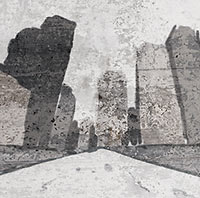 “Actually, Houston has substantially improved both air and water quality in the past few decades. I remember the haze days back in the early 90’s when you could not see more than a few miles through the smog when driving down the Katy Freeway, nor could you see the tops of the taller buildings. Also, nearly all of the illegal water pollution sources have been permitted and/or rerouted into treatment systems. The ones that haven’t are eventually caught and have to pay hefty fines, or the responsible people go to jail. It is true that much of the improvement was driven by federal and state regulation that trickled down to Houston, but that is true for most major cities.” [Superdave, commenting on Comment of the Day: Making Sure the House Wins Houston’s Toxicity Gamble] Illustration: Lulu
“Actually, Houston has substantially improved both air and water quality in the past few decades. I remember the haze days back in the early 90’s when you could not see more than a few miles through the smog when driving down the Katy Freeway, nor could you see the tops of the taller buildings. Also, nearly all of the illegal water pollution sources have been permitted and/or rerouted into treatment systems. The ones that haven’t are eventually caught and have to pay hefty fines, or the responsible people go to jail. It is true that much of the improvement was driven by federal and state regulation that trickled down to Houston, but that is true for most major cities.” [Superdave, commenting on Comment of the Day: Making Sure the House Wins Houston’s Toxicity Gamble] Illustration: Lulu
Comments
COMMENT OF THE DAY: EXCAVATING ELECTION PROCEDURES IN THE LOST CITY OF HOUSTON HEIGHTS 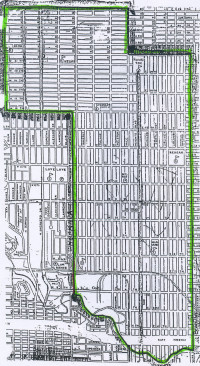 “OK, here’s where things get complicated. The current Alcoholic Beverage Code and Texas election law only provide for the possibility of holding a local option election in a county, municipality or JP precinct. It is therefore not clear that the application for a petition can be accepted as written, since the ‘area formerly known as the city of Houston Heights’ is none of those things. To complicate matters further, if the application were re-submitted as covering Harris County Precinct 1 (which covers the entirety of the dry area), it may still not resolve the matter. Current law essentially says that, for the purposes of local option elections, the vote of a justice precinct doesn’t prevail over the vote of a city, independent of date of election. So the 1918 prohibition election would trump the 2016 local option election. There’s a reasonable reading of this that indicates the only way to allow alcohol sales in the dry Heights is a local option election for the entire city of Houston. Since petitions require a number of signatures exceeding 25 percent of the votes cast in the last general election, the petitioners would need many more signatures than there are actual residents of the affected area. Good luck with that.” [Angostura, commenting on Somebody’s Trying to Legalize Beer and Wine Sales in the Heights Dry Zone] Map of Heights Dry Zone: HoustonHeights.org
“OK, here’s where things get complicated. The current Alcoholic Beverage Code and Texas election law only provide for the possibility of holding a local option election in a county, municipality or JP precinct. It is therefore not clear that the application for a petition can be accepted as written, since the ‘area formerly known as the city of Houston Heights’ is none of those things. To complicate matters further, if the application were re-submitted as covering Harris County Precinct 1 (which covers the entirety of the dry area), it may still not resolve the matter. Current law essentially says that, for the purposes of local option elections, the vote of a justice precinct doesn’t prevail over the vote of a city, independent of date of election. So the 1918 prohibition election would trump the 2016 local option election. There’s a reasonable reading of this that indicates the only way to allow alcohol sales in the dry Heights is a local option election for the entire city of Houston. Since petitions require a number of signatures exceeding 25 percent of the votes cast in the last general election, the petitioners would need many more signatures than there are actual residents of the affected area. Good luck with that.” [Angostura, commenting on Somebody’s Trying to Legalize Beer and Wine Sales in the Heights Dry Zone] Map of Heights Dry Zone: HoustonHeights.org
COMMENT OF THE DAY: MAKING SURE THE HOUSE WINS HOUSTON’S TOXICITY GAMBLE  “Its very clear that the east side of town has the largest concentration of known pollution release points (permitted and otherwise). However, you can also easily see that there are corridors extending to the north, northwest, and south. They follow the most active freight rail lines, and the heavy industry that got built up all around them. And then there’s hazmat stuff like this, which can be located basically in any warehouse, office warehouse, distribution center, or manufacturing facility in any part of town — and it won’t get onto the map. (Remember the explosion in West, TX? Not gonna be on the map.)  . . . If you want the best odds on avoiding all that stuff, then find yourself a relatively new neighborhood that was built as greenfield development, check historical imagery on Google Earth to confirm what was there previously, buy a house in the interior of it, and be sure that you’re getting your water from a large, well-run water system. You should never drive into the city for any sort of business, civic, or educational function without donning a gas mask, and you should bring bottled water from home. Or you could just accept that there are some risks in life and balance them with the things you value — whatever that may be.” [TheNiche, commenting on That Blood Red Stuff in the Bayou May Not Be Spring Branch’s Biggest Problem Right Now] Map of Houston area Superfund sites: EPA Enviromapper
“Its very clear that the east side of town has the largest concentration of known pollution release points (permitted and otherwise). However, you can also easily see that there are corridors extending to the north, northwest, and south. They follow the most active freight rail lines, and the heavy industry that got built up all around them. And then there’s hazmat stuff like this, which can be located basically in any warehouse, office warehouse, distribution center, or manufacturing facility in any part of town — and it won’t get onto the map. (Remember the explosion in West, TX? Not gonna be on the map.)  . . . If you want the best odds on avoiding all that stuff, then find yourself a relatively new neighborhood that was built as greenfield development, check historical imagery on Google Earth to confirm what was there previously, buy a house in the interior of it, and be sure that you’re getting your water from a large, well-run water system. You should never drive into the city for any sort of business, civic, or educational function without donning a gas mask, and you should bring bottled water from home. Or you could just accept that there are some risks in life and balance them with the things you value — whatever that may be.” [TheNiche, commenting on That Blood Red Stuff in the Bayou May Not Be Spring Branch’s Biggest Problem Right Now] Map of Houston area Superfund sites: EPA Enviromapper
COMMENT OF THE DAY: TRACING THE ROOTS OF THE HOUSTON GRID 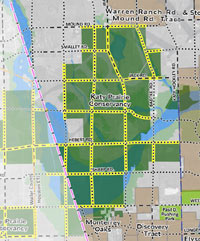 “The Republic of Texas in 1837 created various categories of immigrants in order to assign land grants. The coastal regions and plots fronting major rivers were for the most part already claimed by settlers that had arrived under Mexican governance, so what was allocated for new settlers was primarily west and north of the coast and between rivers. Most of these grants were made in 640-acre (1-square-mile) increments (or double or half that). These were made as geometrically regular as possible given natural features. In the nearly-featureless prairies west of Houston and notably in the Katy Prairie, you had these perfect grids dominating much of the plat maps. Roads and fences were built to follow that pattern for obvious reasons. The legacy of this system has shaped policy ever since.” [TheNiche, commenting on Ring Around the Katy Prairie, and Other Orbital Highway Fun] Map of previously planned thoroughfare routes across Katy Prairie Conservancy preserve: Harris County Planning and Infrastructure Department
“The Republic of Texas in 1837 created various categories of immigrants in order to assign land grants. The coastal regions and plots fronting major rivers were for the most part already claimed by settlers that had arrived under Mexican governance, so what was allocated for new settlers was primarily west and north of the coast and between rivers. Most of these grants were made in 640-acre (1-square-mile) increments (or double or half that). These were made as geometrically regular as possible given natural features. In the nearly-featureless prairies west of Houston and notably in the Katy Prairie, you had these perfect grids dominating much of the plat maps. Roads and fences were built to follow that pattern for obvious reasons. The legacy of this system has shaped policy ever since.” [TheNiche, commenting on Ring Around the Katy Prairie, and Other Orbital Highway Fun] Map of previously planned thoroughfare routes across Katy Prairie Conservancy preserve: Harris County Planning and Infrastructure Department
COMMENT OF THE DAY: WHEN NOT ZONING BECAME BOLD NEW HOUSTON TERRITORY  “. . . Nobody can deny that Houston does things differently, but it does these things in part by not doing something that every other major city does — by bucking the trend despite repeated opportunities to go along with that trend. Houston is so notable in this regard that the Wikipedia page on ‘Zoning in the United States’ has 2 sections of text about the history of zoning: ‘Origins & History’, and ‘Houston’. . . . Houston is the one and only control case that exists by which the impacts of zoning can be tested. To my mind, this qualifies as innovation. Zoning may have been innovative when it was first tried in NYC in 1916, I’ll also grant that — but it’s precisely 100 years later, and — now — Houston’s position is innovative.” [TheNiche, commenting on Houston’s Counterintuitive Optimism; San Jacinto Mall Redo] Illustration: Lulu
“. . . Nobody can deny that Houston does things differently, but it does these things in part by not doing something that every other major city does — by bucking the trend despite repeated opportunities to go along with that trend. Houston is so notable in this regard that the Wikipedia page on ‘Zoning in the United States’ has 2 sections of text about the history of zoning: ‘Origins & History’, and ‘Houston’. . . . Houston is the one and only control case that exists by which the impacts of zoning can be tested. To my mind, this qualifies as innovation. Zoning may have been innovative when it was first tried in NYC in 1916, I’ll also grant that — but it’s precisely 100 years later, and — now — Houston’s position is innovative.” [TheNiche, commenting on Houston’s Counterintuitive Optimism; San Jacinto Mall Redo] Illustration: Lulu
COMMENT OF THE DAY: STRIKING AT OTHER ROOTS OF HOUSTON FLOODING  “St. Augustine grass has a very shallow root system that barely reaches 2 inches into the soil. Beneath that root system is our typical thick clay gumbo soil that is very slow to drain moisture and more prone to let water run off into the storm sewer system. When you plant native grasses and plants, the roots reach down much deeper in the soil and fundamentally change the [bulk] composition of the soil. Instead of the thick gray clay gumbo soil, you get a much looser brown soil that does a much better job absorbing and holding water instead of letting it run off into the storm sewer system . . . Just imagine the amount of water that could be kept out of the storm sewer system if everyone replaced the St. Augustine in their front yard with native grasses and plants.” [Old School, commenting on Houston’s Sustainability Question; Fire Destroys Cleburne Cafeteria in the Middle of the Night] Illustration: Lulu
“St. Augustine grass has a very shallow root system that barely reaches 2 inches into the soil. Beneath that root system is our typical thick clay gumbo soil that is very slow to drain moisture and more prone to let water run off into the storm sewer system. When you plant native grasses and plants, the roots reach down much deeper in the soil and fundamentally change the [bulk] composition of the soil. Instead of the thick gray clay gumbo soil, you get a much looser brown soil that does a much better job absorbing and holding water instead of letting it run off into the storm sewer system . . . Just imagine the amount of water that could be kept out of the storm sewer system if everyone replaced the St. Augustine in their front yard with native grasses and plants.” [Old School, commenting on Houston’s Sustainability Question; Fire Destroys Cleburne Cafeteria in the Middle of the Night] Illustration: Lulu
COMMENT OF THE DAY: A HISTORICAL METHOD OF EXPANDING HOUSTON’S FLOODPLAINS  “Another recent policy development is that subsidence is now taken very seriously (with massive infrastructure being built to put utility districts onto surface water from Lake Houston and the Trinity River). But it was a very, very big problem up until around 1990. So you had all this sprawling development inside of Beltway 8, and off of 1960, and out near West Oaks, and there wasn’t adequate on-site or off-site stormwater retention infrastructure that had been built — and that same development thereafter was sinking at a steady rate, so that any flood control infrastructure was becoming increasingly obsolescent for reasons other than simply rainfall rates and runoff.” [The Niche, commenting on Comment of the Day: Who Foots the Bill for Houston Floods] Illustration: Lulu
“Another recent policy development is that subsidence is now taken very seriously (with massive infrastructure being built to put utility districts onto surface water from Lake Houston and the Trinity River). But it was a very, very big problem up until around 1990. So you had all this sprawling development inside of Beltway 8, and off of 1960, and out near West Oaks, and there wasn’t adequate on-site or off-site stormwater retention infrastructure that had been built — and that same development thereafter was sinking at a steady rate, so that any flood control infrastructure was becoming increasingly obsolescent for reasons other than simply rainfall rates and runoff.” [The Niche, commenting on Comment of the Day: Who Foots the Bill for Houston Floods] Illustration: Lulu
COMMENT OF THE DAY: WHO FOOTS THE BILL FOR HOUSTON FLOODS  “Since much of the development inside the Loop is done over existing impermeable surfaces, it would seem to me that the majority of the additional demand on our bayous is coming from the large greenfield production builders further upstream. My intuition is that the amount of building going on out there most likely dwarfs what’s occurring inside the Loop (can anyone find numbers on this?). And what’s really fueling all that development is the billions of federal, state, and local tax dollars going [toward] expanding and enlarging highway construction all over the place. By reducing the time/cost of commute, they serve as enormous incentives enabling building and selling more cheap houses further away from the employment centers closer to the city. In a nutshell, that is the sprawl Houston is famous for and I think the main source of our flooding woes. There’s no easy answer since we all want cheaper houses — but someone pays for that, somewhere.” [Build Up, commenting on Why Houston Keeps Flooding; Meet Photo Blog Purple Time Space Swamp] Illustration: Lulu
“Since much of the development inside the Loop is done over existing impermeable surfaces, it would seem to me that the majority of the additional demand on our bayous is coming from the large greenfield production builders further upstream. My intuition is that the amount of building going on out there most likely dwarfs what’s occurring inside the Loop (can anyone find numbers on this?). And what’s really fueling all that development is the billions of federal, state, and local tax dollars going [toward] expanding and enlarging highway construction all over the place. By reducing the time/cost of commute, they serve as enormous incentives enabling building and selling more cheap houses further away from the employment centers closer to the city. In a nutshell, that is the sprawl Houston is famous for and I think the main source of our flooding woes. There’s no easy answer since we all want cheaper houses — but someone pays for that, somewhere.” [Build Up, commenting on Why Houston Keeps Flooding; Meet Photo Blog Purple Time Space Swamp] Illustration: Lulu
COMMENT OF THE DAY: HONORING THE SECRET FUNGAL AUTHOR OF THE HOUSTON SAGA  “The toxic mold madness explains the entire history of our region. Think about it: the cannibal Karankawas on the Island of Doom, the ignominious and mysterious defeat of Antonio Lopez de Santa Anna, the mass hallucination that Buffalo Bayou was a navigable waterway on which a major port could be constructed, the race for space, the Candy Man, Mattress Mack and the subsequent mattress obsession, Robert Durst, the tree holocaust, and so on. We should name toxic mold as the official mold of the City of Houston.” [Memebag, commenting on What Floated and What Didn’t by the Halstead Apartments at N. Braeswood and 610] Illustration: Lulu
“The toxic mold madness explains the entire history of our region. Think about it: the cannibal Karankawas on the Island of Doom, the ignominious and mysterious defeat of Antonio Lopez de Santa Anna, the mass hallucination that Buffalo Bayou was a navigable waterway on which a major port could be constructed, the race for space, the Candy Man, Mattress Mack and the subsequent mattress obsession, Robert Durst, the tree holocaust, and so on. We should name toxic mold as the official mold of the City of Houston.” [Memebag, commenting on What Floated and What Didn’t by the Halstead Apartments at N. Braeswood and 610] Illustration: Lulu
COMMENT OF THE DAY: ALL FLOODING BUCKS PASS THE SAME DIRECTION  “Every solid thing built in a floodplain displaces water to the surrounding areas and to downstream. Houston just keeps screwing its southeast neighbors.” [movocelot, commenting on Elan Heights Shows Off Its 4 Floors of Apartment Flooding Insurance]
“Every solid thing built in a floodplain displaces water to the surrounding areas and to downstream. Houston just keeps screwing its southeast neighbors.” [movocelot, commenting on Elan Heights Shows Off Its 4 Floors of Apartment Flooding Insurance]
COMMENT OF THE DAY: BUILD UNTO OTHERS AS YOU WOULD HAVE OTHERS BUILD UNTO YOU 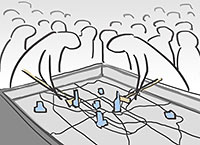 “For this city-wide Houston experiment of no zoning to work, it takes good judgment, responsible developers, people living by the golden rule, doing what’s right, loving thy neighbor, walking a mile in another man’s shoes (or zipcode!), however you get there. I mean that. And I love Houston because — shockingly — this mostly works. When it fails, laws do exist to establish a minimum standard we all live by; those minimum standards [get] called on because someone tried to circumvent the law and selfishly do whatever the hell they wanted anyway.” [G Rod, commenting on The Shakeup Around White Oak Music Hall’s Outdoor Stage] Illustration: Lulu
“For this city-wide Houston experiment of no zoning to work, it takes good judgment, responsible developers, people living by the golden rule, doing what’s right, loving thy neighbor, walking a mile in another man’s shoes (or zipcode!), however you get there. I mean that. And I love Houston because — shockingly — this mostly works. When it fails, laws do exist to establish a minimum standard we all live by; those minimum standards [get] called on because someone tried to circumvent the law and selfishly do whatever the hell they wanted anyway.” [G Rod, commenting on The Shakeup Around White Oak Music Hall’s Outdoor Stage] Illustration: Lulu
COMMENT OF THE DAY: TAKE CARE OF THE OTHER BURIALS BEFORE PUTTING I-45 IN THE GROUND 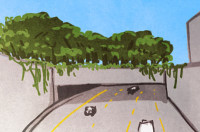 “I don’t understand why people want to bury the Pierce Elevated. That seems like something to put onto the table after all the murders are solved and money starts to rain down from the sky. Can someone explain this to me? How could it possibly be practical to tear down this road?” [Commenter7, commenting on Defending the Pierce Elevated; The First Toucan Traffic Signal in Texas] Illustration: Lulu
“I don’t understand why people want to bury the Pierce Elevated. That seems like something to put onto the table after all the murders are solved and money starts to rain down from the sky. Can someone explain this to me? How could it possibly be practical to tear down this road?” [Commenter7, commenting on Defending the Pierce Elevated; The First Toucan Traffic Signal in Texas] Illustration: Lulu
COMMENT OF THE DAY: BOTH OPTIONS FOR DEALING WITH RUN-OF-THE-MILL HOUSTON TOXICITY 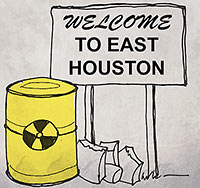 “My wife, until last May, worked at a school very close to this (but [which] was not mentioned). The air pollution on normal days is so bad that my wife’s doctor suggested that if we wanted to have children that she should think about changing jobs.  . . .  Attention is only drawn to the problem when major events happen — but perhaps long term effects of living and working in the area are greater ([and] simply tolerated as business as usual). I have said it before, but it is worth mentioning: I called the TCEQ and many agencies during my wife’s time working over there about the pollution . . .  they informed me that the area has regularly violated EPA standards and my only option was to ‘vote for people who care about government regulation’ of said pollution. Sounds like a tough project!” [Anon, commenting on This Morning’s LyondellBasell Refinery Fire Put Out 19 Hours after Yesterday’s ExxonMobil Refinery Fire] Illustration: Lulu
“My wife, until last May, worked at a school very close to this (but [which] was not mentioned). The air pollution on normal days is so bad that my wife’s doctor suggested that if we wanted to have children that she should think about changing jobs.  . . .  Attention is only drawn to the problem when major events happen — but perhaps long term effects of living and working in the area are greater ([and] simply tolerated as business as usual). I have said it before, but it is worth mentioning: I called the TCEQ and many agencies during my wife’s time working over there about the pollution . . .  they informed me that the area has regularly violated EPA standards and my only option was to ‘vote for people who care about government regulation’ of said pollution. Sounds like a tough project!” [Anon, commenting on This Morning’s LyondellBasell Refinery Fire Put Out 19 Hours after Yesterday’s ExxonMobil Refinery Fire] Illustration: Lulu
COMMENT OF THE DAY: THE JOBS WILL GO WHEREVER THE WIND BLOWS THEM  “I think it has less to do with the location of high-paying jobs, and more [to do with] proximity to the Ship Channel and its pollution. If you look at wind pattern maps, all the historically least-desirable areas are where prevailing winds off the coast end up tending to blow pollution originating from the Ship Channel. The high-income jobs are located west of downtown because that’s where the high-income people wanted to live, not the other way around. This isn’t specific to Houston, either – the west side of most North American cities tends to be the more desirable side, owing to prevailing winds and the location of dirty industrial areas. Chicago is an excellent example — the south side being less desirable owing to its location downwind (south and east) of the massive stockyards that existed there a century ago.” [TMR, commenting on Comment of the Day: Breaking the Cyclical Expansion of the Donut of Despair] Illustration: Lulu
“I think it has less to do with the location of high-paying jobs, and more [to do with] proximity to the Ship Channel and its pollution. If you look at wind pattern maps, all the historically least-desirable areas are where prevailing winds off the coast end up tending to blow pollution originating from the Ship Channel. The high-income jobs are located west of downtown because that’s where the high-income people wanted to live, not the other way around. This isn’t specific to Houston, either – the west side of most North American cities tends to be the more desirable side, owing to prevailing winds and the location of dirty industrial areas. Chicago is an excellent example — the south side being less desirable owing to its location downwind (south and east) of the massive stockyards that existed there a century ago.” [TMR, commenting on Comment of the Day: Breaking the Cyclical Expansion of the Donut of Despair] Illustration: Lulu
COMMENT OF THE DAY: BREAKING THE CYCLICAL EXPANSION OF THE DONUT OF DESPAIR  “Nobody is suggesting that we go back to the old, post-war, car-centric way of developing. Even single family, suburban communities are now being built with something resembling walkability in mind. They have made the houses much more dense, and they have made efforts to link retail to the neighborhoods. But what we risk doing is creating donut cities: with a core of walkability, older suburbs that are not walkable, and a ring of new, sort-of-walkable suburbs. Worse than that, if we continue to starve those older suburbs of investment (on the idea that we don’t want to ‘throw good money after bad’ or whatever), we will create wealthy cores, poor old suburbs, and middle-class new suburbs. Still worse, if we allow this to happen, we will cause more sprawl, because middle class people won’t see the old suburbs as an option, so they’ll keep driving further and further out. At some point, like it or not, we will need to reinvest in those older suburbs – and it’s for the sake of building more sustainable, equitable cities.” [ZAW, commenting on Bellaire’s Hong Kong Chef Serves Last Customers; Sunbelt Cities Are Just Misunderstood; previously on Swamplot] Illustration: Lulu
“Nobody is suggesting that we go back to the old, post-war, car-centric way of developing. Even single family, suburban communities are now being built with something resembling walkability in mind. They have made the houses much more dense, and they have made efforts to link retail to the neighborhoods. But what we risk doing is creating donut cities: with a core of walkability, older suburbs that are not walkable, and a ring of new, sort-of-walkable suburbs. Worse than that, if we continue to starve those older suburbs of investment (on the idea that we don’t want to ‘throw good money after bad’ or whatever), we will create wealthy cores, poor old suburbs, and middle-class new suburbs. Still worse, if we allow this to happen, we will cause more sprawl, because middle class people won’t see the old suburbs as an option, so they’ll keep driving further and further out. At some point, like it or not, we will need to reinvest in those older suburbs – and it’s for the sake of building more sustainable, equitable cities.” [ZAW, commenting on Bellaire’s Hong Kong Chef Serves Last Customers; Sunbelt Cities Are Just Misunderstood; previously on Swamplot] Illustration: Lulu

